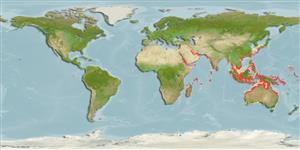Common names from other countries
Classification / Names / Names
Populärnamn | synonymer | Catalog of Fishes (gen., sp.) | ITIS | CoL | WoRMS
Environment: milieu / climate zone / depth range / distribution range
Ekologi
; brackvatten, usually 0 - 25 m (Ref. 75831). Tropical
Indo-West Pacific: Reported from East Africa, including South Africa and the Red Sea, to southern Japan, the Philippines, and eastern Indonesia.
Length at first maturity / Size / Vikt / Age
Maturity: Lm ? range ? - ? cm Max length : 6.0 cm SHL hane/ej könsbestämd; (Ref. 348); common length : 5.0 cm SHL hane/ej könsbestämd; (Ref. 348)
The distribution of this species is imperfectly known because of frequent confusion with other species of the genus (Ref. 348). Found in intertidal areas, in mud and sand, (Ref. 75831) and shallow sublittoral waters (Ref. 348). In sheltered bays and estuaries (Ref. 348).
Life cycle and mating behavior
Könsmognad | Reproduktion | Lek | Ägg | Fecundity | Larver
Members of the class Bivalvia are mostly gonochoric, some are protandric hermaphrodites. Life cycle: Embryos develop into free-swimming trocophore larvae, succeeded by the bivalve veliger, resembling a miniature clam.
Poutiers, J.M. 1998. (Ref. 348)
IUCN Red List Status (Ref. 130435)
CITES status (Ref. 108899)
Not Evaluated
Not Evaluated
Threat to humans
Harmless
Human uses
| FishSource |
Verktyg
Ytterligare information
Age/Size
Tillväxt
Length-weight
Length-length
Morfologi
Larver
Abundans
Internet-källor
Estimates based on models
Preferred temperature
(Ref.
115969): 24.1 - 29.2, mean 28.2 (based on 1694 cells).
Vulnerability
Low vulnerability (10 of 100).
